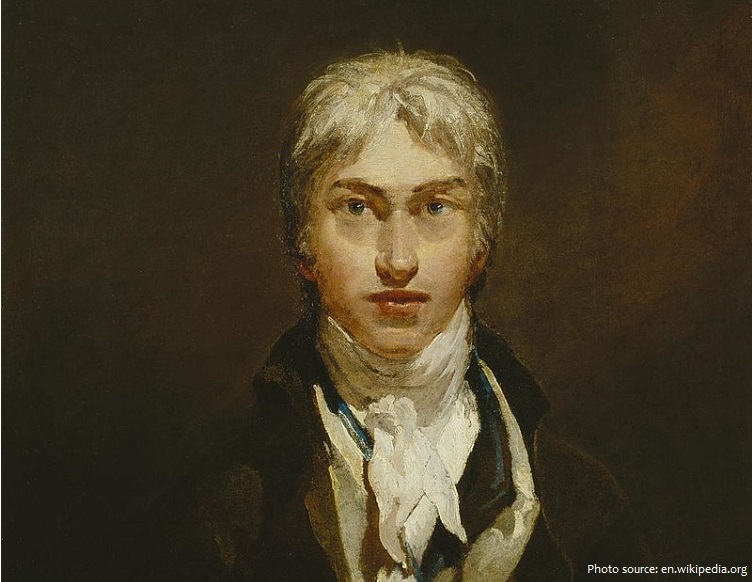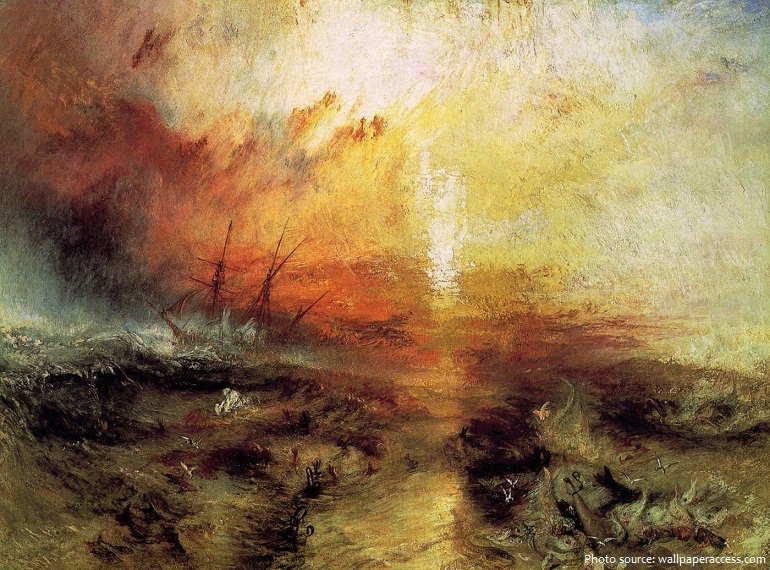
J.M.W. Turner, in full Joseph Mallord William Turner is an English Romantic landscape painter whose expressionistic studies of light, colour, and atmosphere were unmatched in their range and sublimity.
He is known for his expressive colourisations, imaginative landscapes and turbulent, often violent marine paintings. He left behind more than 550 oil paintings, 2,000 watercolours, and 30,000 works on paper.
Joseph Mallord William Turner was born on 23 April 1775 and baptised on 14 May. He was born in Maiden Lane, Covent Garden, in London, England. His father William Turner was a barber and wig maker. His mother, Mary Marshall, came from a family of butchers. A younger sister, Mary Ann, was born in September 1778 but died in August 1783.

At age 10 he was sent to live with an uncle at Brentford, Middlesex, where he attended school. Several drawings dated as early as 1787 are sufficiently professional to corroborate the tradition that his father sold the boy’s work to his customers. Turner entered the Royal Academy schools in 1789 and soon began exhibiting his watercolours there. From 1792 he spent his summers touring the country in search of subjects, filling his sketchbooks with drawings to be worked up later into finished watercolours.
In 1796, Turner exhibited Fishermen at Sea, his first oil painting for the academy, of a nocturnal moonlit scene of the Needles off the Isle of Wight, an image of boats in peril. Wilton said that the image was “a summary of all that had been said about the sea by the artists of the 18th century”.

Turner travelled widely in Europe, starting with France and Switzerland in 1802 and studying in the Louvre in Paris in the same year. He made many visits to Venice. Important support for his work came from Walter Ramsden Fawkes of Farnley Hall, near Otley in Yorkshire, who became a close friend of the artist.
As Turner grew older, he became more eccentric. He had few close friends except for his father, who lived with him for 30 years and worked as his studio assistant. His father’s death in 1829 had a profound effect on him, and thereafter he was subject to bouts of depression.

During the second decade of the 1800s, Turner’s painting became increasingly luminous and atmospheric in quality.
The coming of peace in 1815 allowed Turner to travel abroad. After a trip to the field of Waterloo and the Rhine in 1817, Turner set out in the summer of 1819 on his first visit to Italy.
During the 1820s Turner alternated tours of the continent with visits to various parts of England and Scotland. In 1827 he painted brilliant sketches of the regatta at Cowes, and in 1828 he went to Italy again. From 1828, and particularly after his father’s death in 1829, Turner often visited the earl of Egremont at Petworth, Sussex, producing splendid sketches of the earl’s house and its gardens.
In the later years of his life, Turner was more famous, rich, and secretive than ever. After several years of inactivity as professor of perspective at the Royal Academy, he resigned in 1838.

Before leaving for the Middle East, Daniell commissioned his portrait from John Linnell. Turner had previously refused to sit for the artist, and it was difficult to get his agreement to be portrayed. Daniell positioned the two men opposite each other at dinner, so that Linnell could observe his subject carefully and portray his likeness from memory.
Turner died of cholera at the home of Sophia Caroline Booth, in Cheyne Walk in Chelsea, on 19 December 1851. He is buried in St Paul’s Cathedral, where he lies near the painter Sir Joshua Reynolds. Apparently his last words were “The Sun (or Son?) is God”, though this may be apocryphal.
Turner experimented with a wide variety of pigments. He used formulations like carmine, despite knowing that they were not long-lasting, and against the advice of contemporary experts to use more durable pigments. As a result, many of his colours have now faded. Ruskin complained at how quickly his work decayed; Turner was indifferent to posterity and chose materials that looked good when freshly applied. By 1930, there was concern that both his oils and his watercolours were fading.

Leo McKern played Turner in The Sun is God, a 1974 Thames Television production directed by Michael Darlow. The programme aired on 17 December 1974, during the Turner Bicentenary Exhibition in London. British filmmaker Mike Leigh wrote and directed Mr. Turner, a biopic of Turner’s later years, released in 2014. The film starred Timothy Spall as Turner, Dorothy Atkinson, Marion Bailey and Paul Jesson, and premiered in competition for the Palme d’Or at the 2014 Cannes Film Festival, with Spall taking the award for Best Actor.
The Bank of England announced that a portrait of Turner, with a backdrop of The Fighting Temeraire, would appear on the £20 note beginning in 2020. It is the first £20 British banknote printed on polymer. It came into circulation on Thursday 20 February 2020.